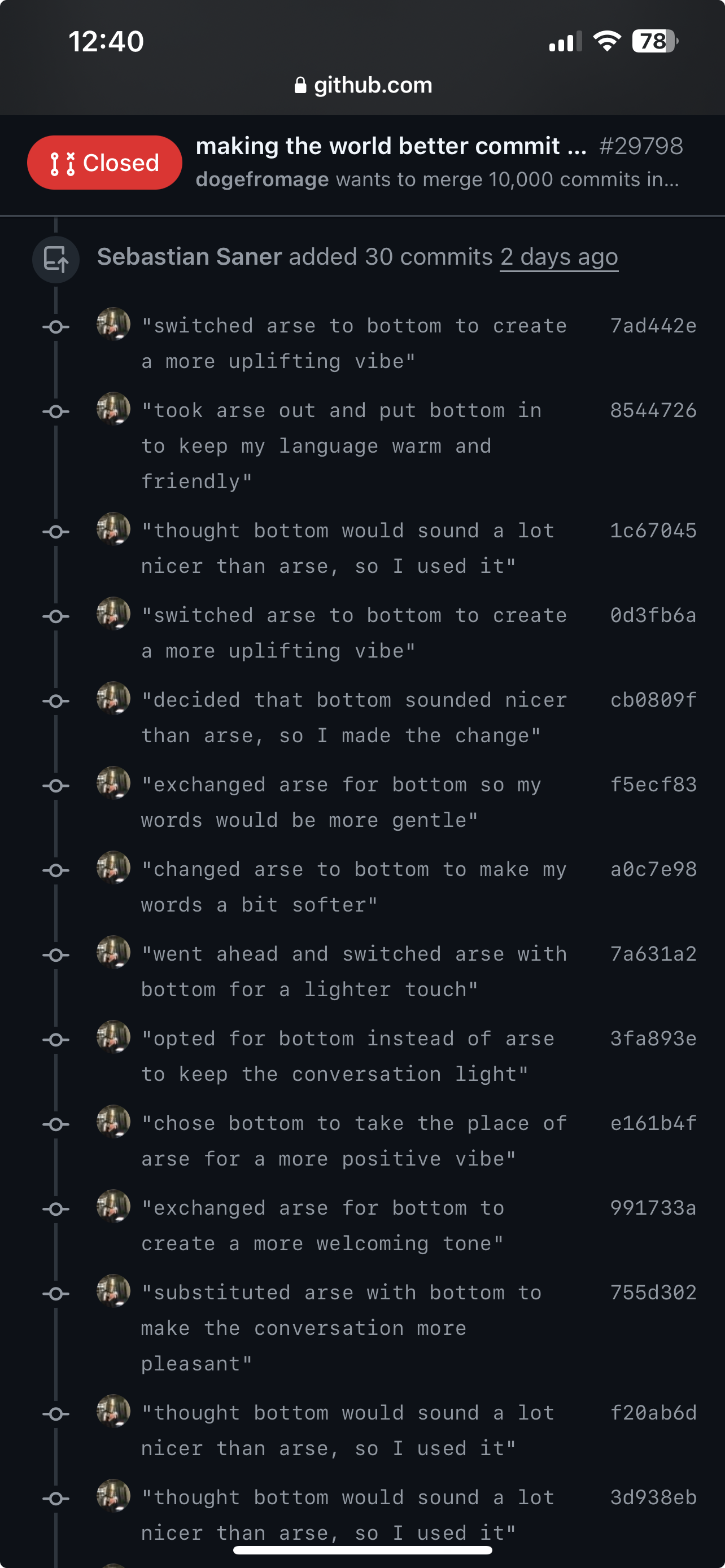I don’t think little of whores…
Says the person who calls prostitutes by a derogatory name. 🙄
Web Developer by day, and aspiring Swift developer at night.
I don’t think little of whores…
Says the person who calls prostitutes by a derogatory name. 🙄



Those commit messages though 🤣


bottombottominate
FTFY
Girl go brrrrr


27 minutes to clean up. 🕰️
I would imagine the soul. The body is used as a means of protecting it from this creature.
My impression is that if your soul is not contained in a body for a long enough period, it becomes a target for a darker being or creature (like how a lion would hunt a zebra).
I would also imagine if your body is not disintegrated, then your soul would remain in the original container, and the clone would be soulless.
That’s fair. How would you go about implementing the service? I always love seeing other people’s perspectives. 😊
I wouldn’t. Not from this example anyway. YAGNI is an important paradigm and introducing plenty of classes upfront to implement trivial checks is overengineering…
Classes, functions, methods… pick your poison. The point is to encapsulate your logic in a way that is easy to understand. Lumping all of the validation logic into one monolithic block of code (be it a single class, function, or methods) is not self-documenting. Whereas separating the concerns makes it easier to read and keep your focus without mixing purposes. I’m very-engineering (imo) would be something akin to creating micro services to send data in and get a response back.
Edit: Your naming convention isn’t the best either. I’d expect
UserInputValidatorto validate user input, maybe sanitize it for a database query, but not necessarily an existence check as in the example.
If you go back to my example, you’ll notice there is a UserUniqueValidator, which is meant to check for existence of a user.
And if you expect a validator to do sanitation, then your expectations are wrong. A validator validates, and a sanitizer sanitizes. Not both.
For the uninitiated, this is called Separation of Concerns. The idea is to do one thing and do it well, and then compose these things together to make your program — like an orchestra.
async function createUser(user) {
validateUserInput(user) || throwError(err.userValidationFailed);
isPasswordValid(user.password) || throwError(err.invalidPassword);
!(await userService.getUserByEmail(user.email)) || throwError(err.userExists);
user.password = await hashPassword(user.password);
return userService.create(user);
}
Or
async function createUser(user) {
return await (new UserService(user))
.validate()
.create();
}
// elsewhere…
const UserService = class {
#user;
constructor(user) {
this.user = user;
}
async validate() {
InputValidator.valid(this.user);
PasswordValidator.valid(this.user.password);
!(await UserUniqueValidator.valid(this.user.email);
return this;
}
async create() {
this.user.password = await hashPassword(this.user.password);
return userService.create(this.user);
}
}
I would argue that the validate routines be their own classes; ie UserInputValidator, UserPasswordValidator, etc. They should conform to a common interface with a valid() method that throws when invalid. (I’m on mobile and typed enough already).
“Self-documenting” does not mean “write less code”. In fact, it means the opposite; it means be more verbose. The trick is to find that happy balance where you write just enough code to make it clear what’s going on (that does not mean you write long identifier names (e.g., getUserByEmail(email) vs. getUser(email) or better fetchUser(email)).
Be consistent:
get* and set* should be reserved for working on an instance of an objectis* or has* for Boolean returnsfetchUser(), validate(), create()UserService.createUser()valid vs isValidconst unless you absolutely have to reassign its direct value; I.e., objects and arrays should be const unless you use the assignment operator after initializationif {} statements. Short-circuiting is cutesy and all, but it makes code more complex to read.{} to create small groups of related code. You’re not penalized for the white space because it gets compiled away anyway.There is so much more, but this should be a good primer.


Thank you. That’s the part I was missing.


I’m confused. The article makes note that, “Mullenweg has demanded a royalty fee of eight percent of WP Engine’s monthly revenue for continued access to Automattic’s WordPress servers and resources.” But then goes on to note that David Hansson, “believes Mullenweg’s actions do not honor the principles set by the GNU General Public License (GPL).”
It sounds to me that Mullenweg wants compensation for their server resources, not use of their Wordpress software — otherwise wouldn’t everybody who uses WordPress outside of wordpress.com be on the hook too?
If that is the case, how is it any different than RedHat charging for support services for their distribution of the Linux kernel and corresponding GNU software?
I feel like I’m missing something here.


Me when I head to the polls next month.





Linus Torvalds: creator of Linux and Git, and hero to all English teachers everywhere!


Stanford has a free introduction course. There is also edX.
Now, I’ve only taken an introduction into cybersecurity at a graduate level, and I will say it’s a difficult career path to master. I’m not saying that to dissuade you, but rather give you a reasonable expectation of the level of effort. But it’s a super fascinating area of computing, and it’s certainly not going away any time soon.
Edit: Oh, and I forgot to mention Bioinfomatics where you could put your existing medical knowledge to use in a computing career.


A lot of technical positions are not getting replaced by computers. Especially cybersecurity.
And that makes it okay how?